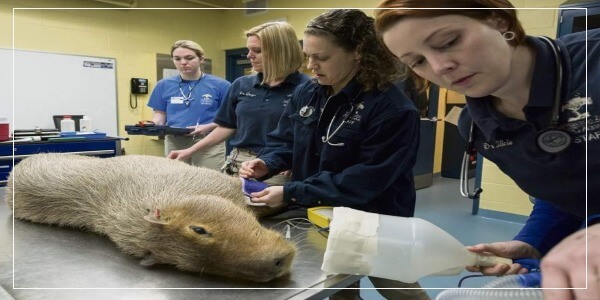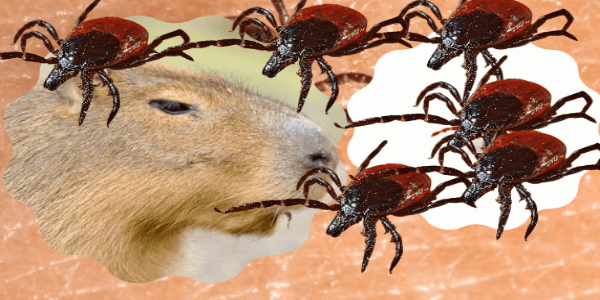Can Capybaras Get Rabies?
Rabies is a deadly viral disease that affects animals and humans.
Rabies is an infectious viral disease that affects the brain and spinal cord of all mammals, including humans. Once clinical symptoms appear, rabies is nearly always fatal. Transmission of the virus usually occurs through a bite from an infected animal; however, transmission can occur when infected saliva enters an open wound or mucous membrane (e.g., nose, mouth, eye).
The majority of rabies cases reported to the Centers for Disease Control and Prevention (CDC) per year occur in wild animals such as skunks, raccoons, foxes, and bats. Humans or animals usually contract rabies from the bite of a rabid animal. It is also very likely to happen but rare that people may get rabies if infectious material from a rabid pet gets directly into their mouth, nose, eyes, or a wound.
What are the Symptoms Of Rabies on Capybaras?
Rabies in capybaras is especially dangerous because the animals do not show any symptoms until it is too late. The symptoms of rabies in capybaras are similar to that of rabies in humans. Capybaras may suffer from irrational moods, signs of aggression, irritability, and restlessness.
So how does a capybara contract rabies?
How do you treat rabies in Capybaras?
Your capybara should be vaccinated against rabies every year. While there is no cure for rabies, you should vaccinate your pet to minimize the risk of contracting it.
If you suspect that your capybara has developed rabies, contact your vet immediately. If a rabid animal bites you or another person, seek medical attention right away.
How do you prevent rabies in Capybaras?
The first step in preventing rabies in your Capybara is to make sure that it is vaccinated against the disease.
Because domesticated Capybaras are usually not allowed to roam freely, they are usually not exposed to wild animals—and wild animals are the most common source of rabies transmission.
If your pet Capybara does roam freely, it will be more likely to come into contact with wild (rabid) animals, so you should consider putting an end to its freedom until you can ensure that such contact will never occur.
The most common way that capybaras can get rabies is by getting bitten by another infected animal.
The most common way that capybaras can get rabies is by getting bitten by another infected animal. Rabies is a virus that spreads through the saliva of an infected animal and can be transmitted by a bite.
Animals that are often associated with transmitting rabies to capybaras include raccoons, foxes, skunks, coyotes, and bats. Because these animals are often nocturnal they travel at night when it is dark outside. This makes them more likely to come across your capybara and potentially attack them.
If a capybara has been bitten, the only way to be sure he doesn’t have rabies is to get him vaccinated.
If you suspect that your capybara has been bitten, the first thing to do is get a vet to check it. If necessary, the vet will be able to give him a rabies shot. (The situation is different if the bite or scratches are from another capybara.) If your capybara is a pet then he should have had his rabies shots as part of his routine vaccinations.
If you are not sure whether your capybara has been bitten then there is a blood test that can be done. This will show whether your capybara has been exposed to rabies. The blood test can be done at most laboratories but it needs to be sent away for testing and takes at least 48 hours or more for results to come back because they need to culture it in the lab first before they can do the test.
How Long Can a Capybara Live with Rabies?
According to the World Health Organization, rabies is a zoonotic virus that kills nearly 60,000 people each year. More than 90 percent of these deaths occur in Africa and Asia. The majority of rabies cases are transmitted by dogs. Yet unlike other animals with shorter lifespans such as cats or dogs, capybaras have been known to live from four to eight years. So then how long can a capybara live with rabies?
A capybara infected with rabies will only live for a few weeks after exposure. In fact, the mortality rate for this type of infection is close to 100 percent in most species. However, there have been cases where some animals have managed to survive for several months or even years without showing any symptoms whatsoever.
This is due mainly to their immune systems being able to fight off the disease before it takes effect (or dying), but also because they’re less likely than other animals due to their larger size and lower body weight relative size compared with other domestic mammals like cats or dogs which means they’re more likely to be able to develop antibodies against the virus over time if exposed early enough during their lifetime before death sets in.
Unfortunately, the answer to that question is: not very long. Rabies is a virus that attacks the central nervous system and can be fatal if not treated promptly. Capybaras are susceptible to contracting rabies just like any other mammal; in fact, there have been recorded incidences of capybaras with rabies in both North and South America.
The capybara’s life expectancy depends on its stage of infection, as well as whether or not it receives treatment. A capybara infected with rabies might live for as little as a few days or as much as several weeks before succumbing to the disease.
It’s important, however, to realize that a capybara’s life span with rabies is completely dependent on when it gets treated (if it does at all). If you suspect your pet capybara has been infected with rabies, take immediate action. Contact your veterinarian and have your capybara put down immediately. The risk of your pet transmitting the disease to you or other animals is too great.
Can a Vaccinated Capybaras Still Get Rabies?
If you’re considering getting a capybara for yourself, you’ll want to take into account the possibility that the animal can contract rabies. While this is uncommon, rabies is a virus that affects the central nervous system and can be deadly if not treated. It spreads through the saliva or brain tissue of an infected animal entering your body through mucous membranes or an open wound. The Centers for Disease Control and Prevention (CDC) say that any mammal can contract rabies, but it’s most common in bats, raccoons, foxes, and skunks.
The CDC also states that once symptoms of rabies appear in the animal, it will die within 10 days. There have been no documented cases of humans contracting rabies from a capybara in the United States. Capybaras can contract rabies from other animals, though. If your capybara has been potentially exposed to another animal with rabies, you should immediately call your veterinarian or local animal control office so they can properly assess whether your pet needs to be quarantined.
Yes but very unlikely! Any capybara can get rabies, regardless of whether the capybara is vaccinated or not depending on the extent of the exposure. Rabies is a virus that can be found in the saliva of infected animals (like bats, raccoons, and skunks), and it’s spread when an uninfected animal comes into direct contact with the infected animal’s saliva. It can also be transmitted by a bite from an infected animal. Rabies isn’t as common as it was in the past, but it’s still around—and it’s very deadly. If a capybara suspects they have been exposed to rabies, they should seek medical help immediately to ensure they don’t come down with the infection.
In fact, most cats and dogs aren’t born with rabies—they acquire it later in life, usually through contact with other animals that are infected. The only exceptions are wild domestic cats, who should receive a rabies vaccine at 3 months old, followed by a booster shot one year later. But if you’ve recently adopted an older cat or dog and you’re unsure whether they’ve already been vaccinated for rabies (or any other diseases), your vet will likely recommend vaccinating them anyway. Vaccination is good for 3 years before any booster shots are needed.
Can You Get Rabies by Touching Capybaras?
Can you get rabies by touching capybaras? The answer is no. It’s an understandable question to ask, especially if you’re a fan of these adorable rodents. The truth is that the capybaras’ natural habitats in South America carry plenty of other diseases that can be passed on to humans, but rabies is not one of them.
Rabies is spread through the bite of an infected animal, and although capybaras will nip at each other during mating season, they are generally too friendly toward humans to pose a risk. In fact, there have been numerous reports of capybaras being affectionate toward their owners—one story even claims that a capybara named Cheesecake once escaped from her home and returned a month later having gained 15 pounds from eating bananas at the zoo!
In addition to being cute and cuddly, these animals are also herbivores and therefore eat only plant-based foods. So if you’re thinking about getting a pet capybara for yourself, be prepared to make room in your house (and your heart) for this lovable giant rodent!


![Is it healthy to kiss a pet capybara? [Answered] Kissing A Capybara](https://capybaratips.com/wp-content/uploads/2022/11/Kissing-A-Capybara.png)



![How Long Do Capybaras Live? - [Answered] How Long Do Capybaras Live](https://capybaratips.com/wp-content/uploads/2023/03/Capybara-Pix-250x200.webp)


